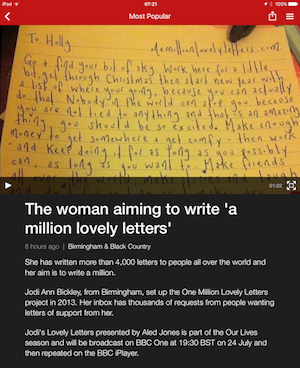Lovely letters
The ‘One Million Lovely Letters’ project started as a one-woman enterprise and a kind of mutual support-giving activity which has recently been the subject of a BBC television documentary.

Jodi Ann Bickley, joined by some ten other letter-writers, writes ‘lovely letters’ to people who contact OMLL requesting these via the project’s website and email address, something which arose from taking control over her life following serious illness caused by Lyme disease (no joke, I’ve had a mild version and a colleague a life-threatening encounter). The OMLL letters respond to the requests made and provide positive comments, help and encouragement and seem to be much appreciated by their recipients. She has already hand-written thousands, with them being hand-written a hallmark of the project, and the aim is to write a million.

There is a book, shown on the screenshot above, and the website, shown in the screenshot below, will be found at: https://onemillionlovelyletters.com/meettheteam/

Some interesting questions arise. Are these ‘real letters’? They are solicited, and solicited by people who are otherwise strangers to each other and are likely to remain so. But then, ‘real letters’ can arise in similar circumstances, such as those that volunteer pen-friends write to life prisoners who make a request to be allowed to have a penfriend relationship, and some well-known work has been done on the epistolary and other aspects of these.
The OMLL letters are ‘lovely’ in the sense that they only provide positive comments and responses, which probably makes them different from the general run of letters. These tend to be much more quotidian and everyday, and when not to be more nuanced although sometimes prickly or even negative – you owe me three letters, why haven’t you written, it’s just like you, wrote Lizzie Forbes to her brother James, to mention an instance from the Forbes Family Letters.
Also, it seems (although this may be incorrect) that, although in some respects extremely personal, these are one-off missives and not a moment within an epistolary relationship sustained over time. But then, the one-off letter is not unknown in the general run of letter-writing. And also it is possible that some of these OMLL missives do give rise to longer-term exchanges.
The OMLL are real letters of a kind, then, and this is a rather artificial kind, although it needs to be recognised such artifices occur ‘naturally’ as well in the rather deliberate way that this project originated. A more concerning thought to finish with.
While epistolarity is flourishing apace and morphing into such things as text and email, the conventional way in which epistolary exchanges are conceived – the letter – is declining and probably even nose-diving. Without a radical shift in thinking towards epistolarity, and away from the preoccupation with ‘the letter’, research and writing in the future is liable to associate letterness with such things as these handwritten ‘lovely’ letters rather than with the myriad of complicated forms that are presently coexisting. Obviously this emphasis is not the fault or the responsibility of the OMLL project, but is rather built into how this area of scholarly work is conceptualised. Imagining a situation in which these particular letters are seen to stand for ‘the letter’, for epistolarity as such, immediately shows the problems. Thinking outside the box here requires thinking outside ‘the letter’ conceived narrowly.
Last updated: 27 July 2017





